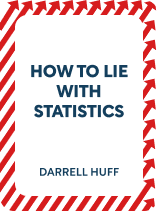

This article is an excerpt from the Shortform book guide to "How to Lie With Statistics" by Darrell Huff. Shortform has the world's best summaries and analyses of books you should be reading.
Like this article? Sign up for a free trial here .
Do you want to further your understanding of How to Lie With Statistics? Are you looking for practice questions to help you evaluate statistics?
In Darrell Huff’s book, he explains how people with an agenda can manipulate statistics in their favor. We’ve put together some practice exercises to help you evaluate statistics better with Huff’s methods.
Keep reading for How to Lie With Statistics practice questions.
Practice Questions From How to Lie With Statistics
Have you ever wondered how the people who publish statistics so often turn up numbers that support their position? Sometimes, the numbers really do support the person or group publishing them, but statistics aren’t as objective as we might like to believe.
In Darrell Huff’s book, How to Lie With Statistics, he explains the methods used to manipulate statistics. Here are some How to Lie With Statistics practice questions to help you understand the book further:
Exercise: Look for Fudged Numbers
There are five techniques liars use to fudge the numbers.
- Imagine you read that the average income of an Ivy League graduate is $70,562. What lying techniques were possibly used in generating this stat? How do you know?
- Imagine you read that a company’s return-on-investment has increased since last year by 1.34%. What lying techniques were possibly used in generating this stat? How do you know?
Exercise: Assess a Graph
There are many techniques liars use to make graphs misleading.
- Which of the liars’ techniques do you spot in the line graph below?
- Which of the liars’ techniques do you spot in the bar graph below?
Exercise: Assess a Statistic
There are five questions to ask when you encounter a statistic to assess its legitimacy.
- Consider this statistic published by a company selling blue wallpaper: “According to a survey of parents conducted by our company, an average of 97.68% of infants cry when in a room with green-colored wallpaper. Therefore, most infants hate living in homes with green wallpaper.” What is the original source of this stat? How might this affect its reliability?
- How was the data that produced the stat collected? (For example, did interviewers poll people, was an online survey advertised on social media, and so on?) Can you think of any reason people who participated might have given untrue answers?
- What missing information may be relevant to interpreting the statistic?
- Could any of the words surrounding the statistic have more complicated meanings than what’s in the dictionary? What could they also mean?
- Does the figure seem right? (For example, does it contradict common sense or have any obvious fact-checking errors?) Why or why not?

———End of Preview———
Like what you just read? Read the rest of the world's best book summary and analysis of Darrell Huff's "How to Lie With Statistics" at Shortform .
Here's what you'll find in our full How to Lie With Statistics summary :
- The 10 ways you might end up fooled by statistics
- How to differentiate between legitimate and lying statistics
- Why you can't even trust a graph






